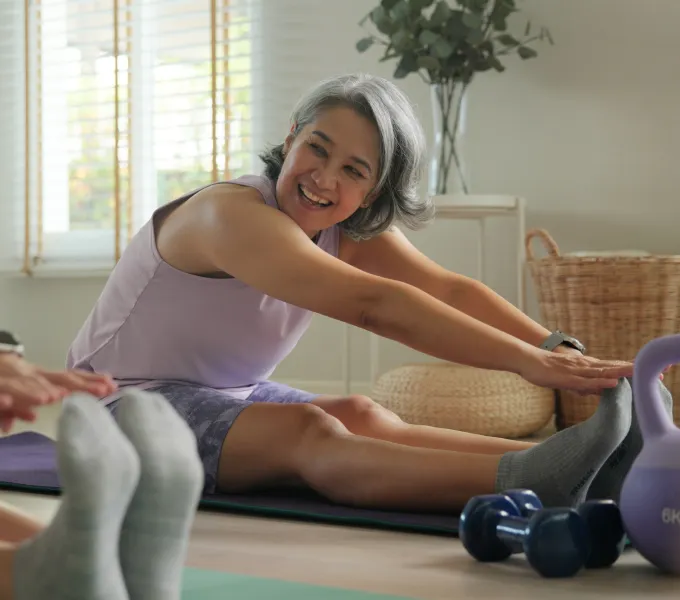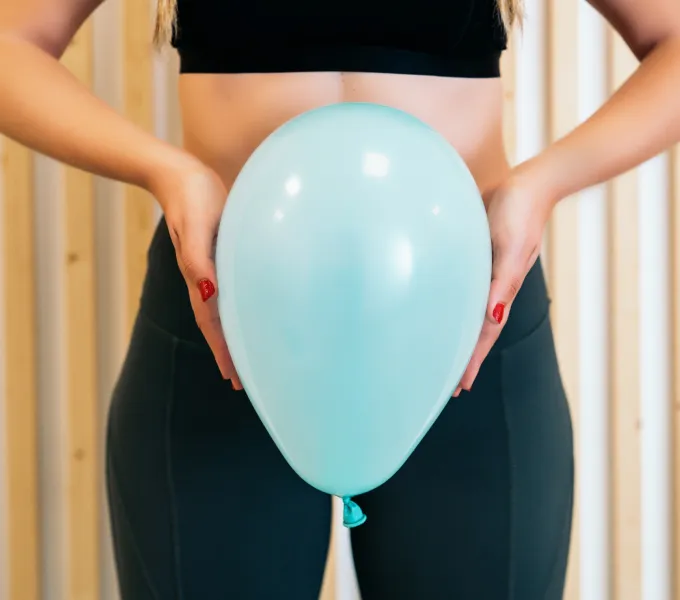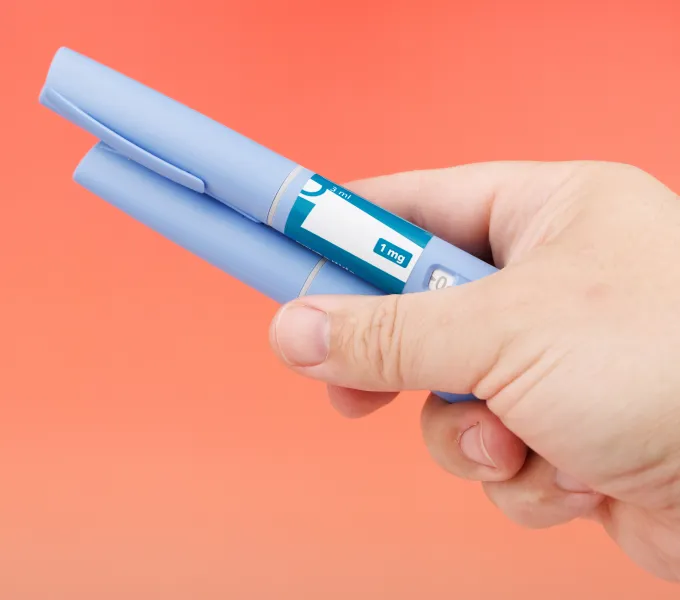
The Pelvic Floor Self-Check: A Step-by-Step Guide
By the time you were 18, you’d probably heard the “mirror down there” advice at least once, if not a dozen times. The gist: Hold a mirror between your thighs and take a good long look at your vulva. And we hope you did, because everything from inserting a tampon to explaining what turns you on is easier when you know your anatomy. As helpful as looking can be, it's just a starting point. As pelvic floor physical therapists, we can tell you that there’s a lot to be gained from a deeper dive.
For anyone ready to level up their understanding of their body, we encourage you to give yourself a pelvic self-check. It’s not only easier than you might think, there are surprising benefits to exploring your pelvic floor.
Your pelvic floor muscles form a bowl at the bottom of your pelvis and wrap around your urethral, vaginal, and anal openings (see a diagram here). These muscles are responsible for key functions including supporting your pelvic organs, holding in pee and poop, and allowing for pain-free, pleasurable sex. If they’re not working properly, symptoms can include pain with sex, bladder/bowel leaks, and conditions like pelvic organ prolapse. These things all fall under the category of 'pelvic floor dysfunction.'
A pelvic self-check can clue you in to how your pelvic floor is working and feeling, right now. If anything seems off, you can reach out to your GYN or a pelvic floor physical therapist to ask questions and get the care you need.
Prepare to Explore Your Pelvic Floor
The following self-check is generally considered safe and easy to perform for everyone. But there are cases when you should check with a healthcare provider first, to make sure it’s safe for you.
When to consult your care provider first:
- If you’re pregnant
- If you have a vaginal infection or active herpes lesions
- If you’re earlier than 6 weeks postpartum and haven’t been cleared by your OB for vaginal penetration
- If you've recently had vaginal or pelvic surgery or radiation
- If you have any unexplained vaginal or rectal bleeding
Take notes as you perform your self-check. If you’re unable to complete the self-check due to pain or for any other reason, stop there and write down what you felt. Reach out to a GYN or a pelvic floor PT if you find anything at all that concerns you.
What you’ll need:
- A mirror (or your phone camera)
- A few pillows
- A pen and paper to take notes
- A clean cotton swab
- Personal lubricant (olive oil works, too)
When you’re ready, empty your bladder, wash your hands, and head to a space where you can get comfortable — a bed is perfect.
Next comes the trickiest part of this whole process: finding a comfortable way to see your anatomy.
Positions to try:
- If you have a wall mirror, pull a chair up in front of it. Sit back in the chair and draw your thighs up to your chest (hold your shins with your hands to support your legs).
- If you have a makeup mirror (or are using your phone), sit with your back against the headboard of your bed (legs bent and feet on the bed) and place the mirror between your legs, using one or more books to support it. Piling some pillows under your butt can make this more comfortable.
Even in these positions, your pubic hair and the folds of your labia, belly, or inner thighs may make it difficult to see your anatomy clearly. Use your hands as much as necessary to shift your body parts around and get a good line of sight.
(In case you're interested, there is a beautiful mirror that's ergonomically designed just for this special case!)
Pelvic Self-Check: Know your anatomy
To start, take a minute to just look, which can be helpful for 1) admiring the awesomeness of the vulva and 2) reminding yourself where everything is and what it looks like, just in case it's been a while.
What to do:
Examine your vulva (this includes your clitoris, inner and outer labia, vaginal and urethral openings, and your perineal body — the area between your vaginal and anal opening). Then use your fingers to open up the outer labia — these are the larger folds of tissue and may or may not have pubic hair on them — to get a better view.

Pelvic Self-Check: Perineal Body Movement
The first stop on your pelvic floor tour is the perineal body, which is the tissue between your vaginal and anal openings, where your pelvic floor muscles meet. Find the perineal body on the diagram above.
Your muscles' ability to contract, relax and bulge are integral for supporting bladder, bowel, and sexual health. You can see this movement in your perineal body, and it can give you helpful insight into whether or not your muscles are working properly.
Step 1
What to do:
Try to do a Kegel by engaging or tightening your pelvic floor muscles as if you were trying to stop the flow of urine, hold back gas, or draw up a marble with your vagina.
What to look for:
You may note your clitoris "nodding" down, your anal sphincter drawing in or "winking," and your perineal body moving inward/away from the mirror. These are all signs your muscles are contracting properly. When you relax your muscles, everything should return to its starting position.
Could you see your pelvic floor move inwards & tighten when you engage your muscles? (You may need to use your hands to adjust your pubic hair and labia so that you can see.)
- Yes, I see a good contraction and relaxation
- No, it didn’t seem to move
- No, it seemed to move in the opposite of what I was supposed to see!
- Not sure
Step 2
What to do:
Next, try to lengthen and open your pelvic floor. Pretend you are gently bearing down for a bowel movement.
What to look for:
You should see the perineal body stretch or move downwards towards the mirror, or even the opening of the anus. Check your vaginal opening now. You may also see tissue bulging out towards the entrance of the vagina. Could you see your perineal body bulge and move towards the mirror?
- Yes, a lot
- Yes, a little
- No, it didn't seem to move
- No, it seemed to lift/move away from the mirror
- Not sure
Did you see any other tissue bulging out towards the opening of the vagina or past the entrance of the vagina?
- Yes, I saw something drop towards the opening
- Yes, something came outside of the vaginal opening
- No
- Not sure
Step 3
What to do:
Cough a few times.
What to look for:
You should see your perineal body lift/contract (remember, this means a pelvic floor muscle contraction) when you cough. This is helpful in supporting your pelvic organs when you cough, and preventing bladder leaks!
What happens at the perineal body when you cough?
- It lifts up and away from the mirror
- It doesn’t seem to move
- It bulges or pushes down towards the mirror
- Not sure
Pelvic Self-Check: Tissue Sensitivity
Now, let's take a more careful look at your vulva and examine your pelvic floor muscles — the main target of this self-check. These muscles are located underneath the tissues of your vulva, deep inside of your pelvis. You’ll be checking them for knots, tension, tenderness and the ability to contact/relax, which can all affect how well they function.
Step 1
What to do:
Take the Q-tip and gently touch tissues around the vaginal entrance, the urethral opening, and the perineal body. Use the diagram below as a guide. Move around the openings in a clockwise direction.

What to look for:
Make note of any sensitive or tender areas (plus any skin issues, like redness or bumps). For example, you might write down that something felt “extra tender around 2 o’clock.”
Step 2
What to do:
Place a little bit of lubricant on a clean (or gloved) finger, then fully insert your finger into your vaginal opening. Inserting your finger should be pain-free, so if this causes any pain or discomfort, stop your pelvic floor check and instead check in with your doctor or pelvic floor PT so they can help you determine what could be causing your pain. Squeeze your pelvic floor muscles around your finger to try and pull your finger in further. Then allow your muscles to relax.
What to look for:
As you squeeze your muscles, note if you feel pressure around your finger and a pull upwards (towards your pubic bone). As you relax your muscles, see if you can feel them fully release and soften.
When you squeeze, how strong does the pressure around your finger & upward pull feel?
- Strong
- Weak
- I can't feel anything
When you stop squeezing, do your muscles relax easily?
- Yes
- No
- I can't feel anything
Step 3
What to do:
Next, try to bulge your pelvic floor, or bear down like you’re having a bowel movement.
What to look for:
You should feel your muscles attempt to push your finger out from your vagina and release away from your finger.
Do you feel your muscles push your finger out?
- Yes
- No, I felt my muscles tighten around my finger
- Not sure
Step 4
What to do:
Next, apply gentle, but firm pressure to the muscles moving around in a clockwise fashion. Remember the diagram above as a guide. You should avoid the 12 o’clock position so you are not pressing directly on your urethra.
What to look for:
Ideally, you want to feel that the muscles are soft (like when you press your finger into the meaty muscle at the base of your thumb) and are pain-free. Make note of any areas of sensitivity, tenderness, etc.
Ok, did you do it? How did it go? Remember, the purpose of this self-check isn’t to diagnose pelvic floor muscle dysfunction, it’s to empower you with knowledge about this incredible area of your body. If you found anything you’re unsure or concerned about, especially if you’re experiencing symptoms like pelvic pain, pain with sex, bowel or bladder leakage, or pelvic heaviness, make an appointment with your GYN or a pelvic floor physical therapist and bring your notes with you!




